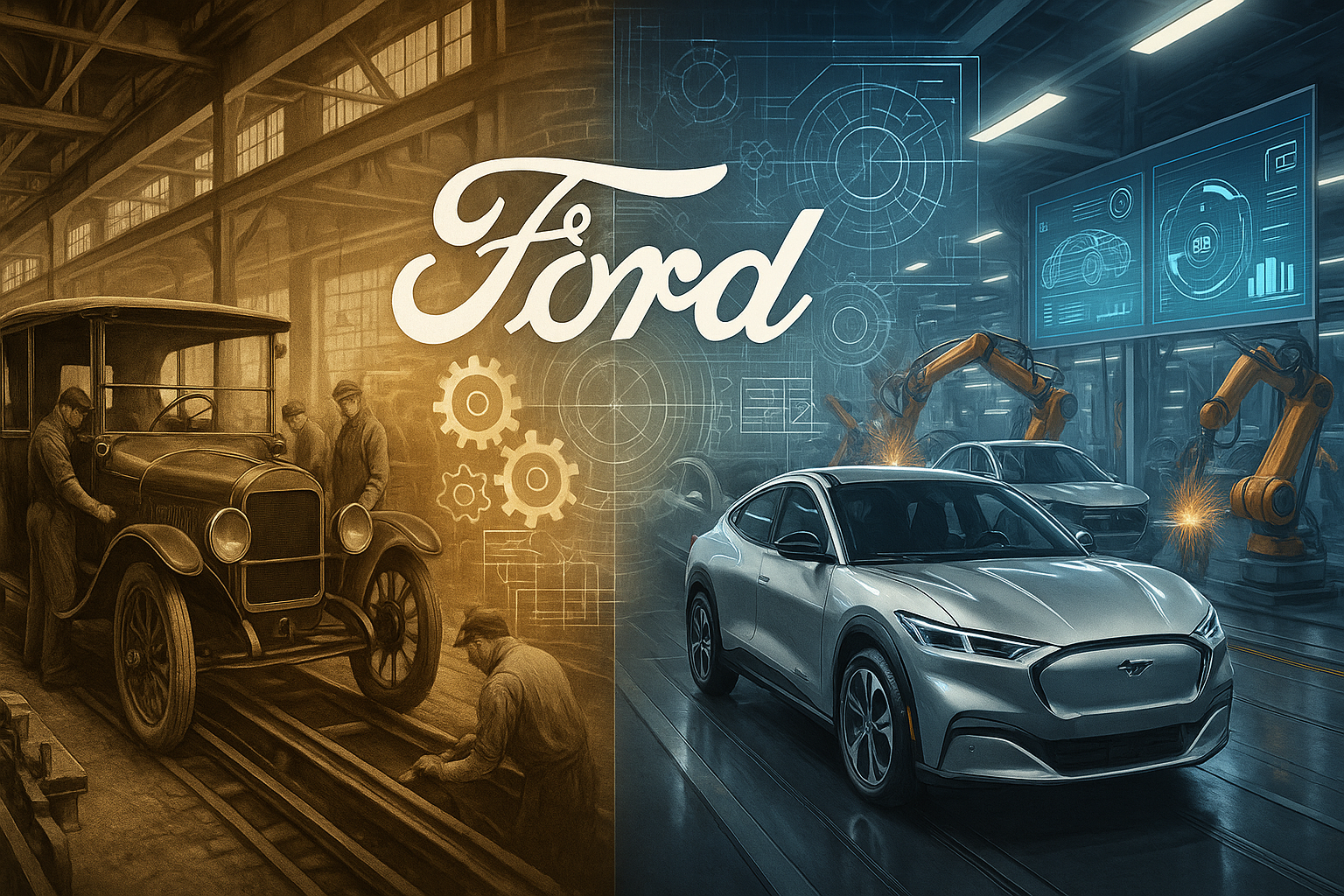
Ford Motor Company (NYSE: F), a name synonymous with American ingenuity and industrial might, stands as a titan in the global automotive industry. From its humble beginnings in a converted factory, Ford revolutionized manufacturing, democratized the automobile, and profoundly shaped the 20th century. More than just a car manufacturer, Ford became a symbol of progress, innovation, and the pursuit of accessible mobility for the masses. Its journey is a testament to visionary leadership, relentless innovation, and an enduring commitment to shaping the future of transportation.
Foundation and Early Years
The story of Ford Motor Company begins with the unwavering vision of Henry Ford, a man determined to put the world on wheels. Officially incorporated on June 16, 1903, in a converted wagon factory in Detroit, Michigan, this venture marked Ford's third attempt at establishing a successful automobile manufacturing business. His earlier endeavors, the Detroit Automobile Company and the Henry Ford Company, had faltered, but Ford's resolve remained unbroken. With $28,000 in capital from twelve investors, including Ford himself, the Ford Motor Company was born.
Ford's initial business model focused on producing high-quality, rugged, and easy-to-maintain automobiles. In its nascent years, production was limited, with small teams of workers assembling vehicles from parts largely sourced from external suppliers. The true turning point arrived in 1908 with the introduction of the Model T. Henry Ford's audacious vision was to create an automobile that was not a luxury item, but an affordable and accessible necessity for the "great multitude"—the average American family. Priced initially at $850, significantly less than its contemporaries, the Model T was designed for efficiency, reliability, and widespread appeal.
The early years were not without their formidable challenges. Limited production volumes and high manufacturing costs, inherent in the craft-based assembly methods of the time, kept automobile prices out of reach for most. Ford's revolutionary solution was the moving assembly line, first implemented in 1913 at the Highland Park plant. This innovation dramatically slashed the time required to assemble a Model T chassis from 12 hours to a mere 90 minutes, enabling unprecedented scale and significantly lower production costs. By 1925, the price of a Model T plummeted to as low as $260, making car ownership a reality for millions.
Another significant challenge was high labor turnover and absenteeism, a common issue with the repetitive nature of early assembly line work. Ford addressed this in 1914 with the groundbreaking announcement of the $5 workday, more than doubling the average wage at the time. This bold move not only drastically reduced employee turnover and attracted skilled labor but also empowered Ford's own workers to afford the very cars they were building, thereby expanding the consumer market. Ford further pioneered the five-day, 40-hour workweek in 1926. Furthermore, to reduce dependence on external suppliers and ensure quality control, Ford embarked on a strategy of vertical integration, bringing much of the parts production in-house. This control over the entire manufacturing process, from raw materials to finished product, along with the standardization of parts, further reduced costs and simplified repairs. While the Model T dominated for years, emerging competition and changing consumer demands for more variety eventually led to its discontinuation in 1927, replaced by the more modern and diverse Model A, demonstrating Ford's eventual adaptation to market evolution.
Growth and Development
Ford's trajectory from a nascent automaker to a global powerhouse is marked by a series of pivotal milestones, strategic market expansion, and continuous product evolution. The introduction of the Model T in 1908 was the catalyst for unprecedented growth. Designed to be affordable, durable, and easy to maintain, the Model T democratized car ownership, transforming transportation and society itself. The revolutionary moving assembly line, implemented in 1913, was the engine of this transformation, drastically cutting production times and costs. By 1914, Ford was producing more cars than all other automakers combined, and by 1920, half of all cars in the U.S. were Model Ts. Over 15 million Model Ts were sold before production ceased in 1927.
Beyond the Model T, Ford continued to innovate and expand its product portfolio. In 1922, the acquisition of the Lincoln Motor Company marked Ford's entry into the luxury vehicle market. The Model A, introduced in 1927 as the successor to the Model T, featured significant improvements, including a safety glass windshield. A major engineering feat followed in 1932 with the introduction of the first low-cost V-8 engine, making high performance accessible to a broader market. In 1939, the Mercury division was established to compete in the mid-price segment. During World War II, Ford leveraged its mass production capabilities to contribute significantly to the Allied effort, notably by producing B-24 Liberator aircraft. Under the leadership of Henry Ford II, the company launched iconic models like the Thunderbird (1954) and the Mustang (1964), with the Mustang becoming a cultural phenomenon and a symbol of American muscle and freedom.
Ford's market expansion began almost immediately after its founding. Its first international plant opened in Walkerville, Ontario, Canada, in 1904, serving as a hub for sales across the British Empire. In 1908, Ford established its first international sales branch in Paris, followed by rapid overseas expansion with assembly plants in Ireland (1917), England (1911), France, Denmark (1923), Germany (1925), Austria (1925), Argentina (1913, 1925), South Africa (1924), Australia (1909, 1925), and Japan (1925). By the end of 1919, Ford was producing 50% of all cars in the United States and 40% of all British cars, with the Model T assembled in 19 countries and sold in many more by 1927. This early and aggressive internationalization cemented Ford's position as a truly global enterprise.
Product evolution continued through the latter half of the 20th century and into the 21st. The 1980s and 1990s saw a shift towards fuel-efficient cars and trucks, exemplified by the aerodynamically designed Ford Taurus (1986) and the popular Explorer SUV. Ford has consistently been an early adopter of advanced technologies and safety features, including driver-assist systems like the Blind Spot Information System (BLIS) and Continuously Controlled Damping (CCD), and pioneered crash testing in the 1950s and 1960s. In the 21st century, Ford has embraced electrification and sustainability, launching hybrid models like the Ford Fusion Hybrid in 2009. Today, the company is making significant investments in electric vehicles (EVs), with models such as the Mustang Mach-E and the all-electric Ford F-150 Lightning. Ford aims for 40% of its global vehicle volume to be fully electric by 2030 and has reorganized its business into Ford Blue (traditional ICE and hybrid vehicles), Model e (electric vehicles and advanced technical development), and Ford Pro (commercial vehicles and services) to align with this strategic shift. Beyond vehicle manufacturing, Ford is also expanding into mobility services, including e-commerce and digital sales platforms, and exploring micromobility solutions. Its F-Series truck has maintained its position as America's top-selling truck for 45 consecutive years, underscoring Ford's enduring strength in the commercial vehicle segment.
Major Achievements
Ford Motor Company's history is replete with groundbreaking achievements that have not only defined the automotive industry but also left an indelible mark on global industry, economics, and labor practices.
At the forefront of these achievements is the perfection of mass production and the moving assembly line. While Henry Ford did not invent the automobile or the assembly line, his refinement and implementation of the moving assembly line in 1913 at the Highland Park plant revolutionized manufacturing. This innovation dramatically reduced the time required to build a car, making mass production at unprecedented scales possible and significantly lowering costs. This system, famously known as "Fordism," transformed countless sectors beyond car manufacturing, making products affordable for the middle class and fundamentally altering industrial processes worldwide.
The Model T, introduced in 1908, stands as another monumental achievement. It was the first truly affordable mass-produced automobile, making car ownership accessible to the average person. Its robust design, simple mechanics, and high ground clearance made it versatile and suitable for various terrains. The Model T's immense success shifted the automotive industry's focus from luxury vehicles to practical, sturdy, and inexpensive cars. By 1921, the Model T accounted for almost 57% of the world's automobile production, becoming the industry's first truly global car.
Ford was also a pioneer in the standardization of parts, which significantly reduced production costs, increased efficiency, and simplified vehicle repair and maintenance for customers. Furthermore, Ford was one of the first companies to offer significant employee benefits, notably the $5-a-day minimum wage in 1914 (double the prevailing wage) and an eight-hour workday. These progressive labor practices helped stabilize the workforce, attract skilled labor, and are often cited as a crucial factor in the establishment of the American middle class.
In terms of modern innovations, Ford has been an early adopter of advanced driver-assist systems like the Blind Spot Information System (BLIS), paving the way for many contemporary collision-avoidance technologies. The company is also a leader in electrification and sustainable practices, committing billions to electric vehicle (EV) technology with plans for over 40 EV and hybrid models. Ford aims for global carbon neutrality by 2050 and has made significant strides in reducing its environmental impact, including a 70% reduction in operational water use since 2000. The establishment of an Advanced Manufacturing Center (AMC) further underscores Ford's commitment to cutting-edge technologies like collaborative robots, 3D printing, augmented reality, and virtual reality to enhance manufacturing efficiency.
Ford Motor Company has garnered numerous awards and recognitions throughout its history. Its vehicles have consistently received design accolades, including multiple Red Dot Awards for models like the all-electric Ford Explorer and the Ford Fiesta. In sustainability, Ford has been recognized by CDP for its leadership in tackling climate change and protecting water security, securing a place on their prestigious 'A List' for multiple years. It was also the first automaker to receive the U.S. Environmental Protection Agency's Energy Star Partner of the Year Award in Energy Management two years in a row. Ford vehicles have also won multiple Popular Mechanics Automotive Excellence Awards and consistently receive Kelley Blue Book "Best Buy" awards for models like the F-150, F-150 Lightning, Maverick, and Expedition. J.D. Power awards for initial quality have also been bestowed upon Ford vehicles, including the F-150 and Mustang. Beyond product-specific awards, Ford has been recognized for its corporate culture, leadership, and diversity by Comparably, winning awards such as "Best Company Culture" and "Best Leadership Teams."
In terms of market leadership positions, Ford's dominance in the early 20th century was unparalleled, with the Model T accounting for more than half of all registered automobiles worldwide by the early 1920s. Today, the Ford F-150 pickup remains one of the best-selling vehicles in the United States for several decades, with the F-Series consistently leading truck sales. Ford's electrified vehicle sales are experiencing rapid growth, representing a significant portion of its total sales. With vehicles sold in over 180 countries, Ford maintains a robust global presence. As of 2022, Ford holds a substantial 13.9% of the U.S. automotive market share, solidifying its position as the second-largest U.S.-based automaker.
Corporate Culture and Leadership
Ford Motor Company's corporate culture and leadership have been shaped by a succession of influential figures, a steadfast commitment to core values, and an evolving organizational philosophy.
At the helm for much of its formative years was Henry Ford, the visionary founder. His contributions were monumental, not only in establishing the company but in revolutionizing the automotive industry through the introduction of the moving assembly line and mass production techniques. His innovations, which made automobiles affordable for the middle class with the Model T, were so impactful that the term "Fordism" emerged to describe the mass production and consumption they enabled. Henry Ford also pioneered progressive labor practices, notably the five-day, 40-hour workweek for his employees in 1926.
Following his father, Edsel Ford served as president from 1919 to 1943. Despite navigating a complex relationship with his father, Edsel played a crucial role in Ford's resurgence in the late 1920s with the introduction of the Ford Model A and oversaw the acquisition of Lincoln Motor Co., establishing Ford's luxury brand. The company's post-World War II revival was spearheaded by Henry Ford II, grandson of the founder, who took the reins in 1945. He brought in a team of management and finance experts, known as the "Whiz Kids," to restructure the company's finances and eliminate inefficiencies, bringing Ford back from the brink of bankruptcy. Under his leadership, Ford became a publicly traded company and launched iconic vehicles like the Thunderbird and Mustang.
Later, non-family leaders like Philip Caldwell (CEO 1979-1985) and Donald Petersen (CEO and Chairman 1985-1990) initiated and continued the company's turnaround, focusing on improving manufacturing efficiency, vehicle quality, and fuel efficiency. However, one of the most significant leadership contributions in recent history came from Alan Mulally (CEO 2006-2014). Credited with one of the most remarkable turnarounds in business history, Mulally implemented the "One Ford" plan, which unified the global organization, streamlined operations, and refocused on delivering quality, fuel-efficient, safe, and well-designed vehicles. His leadership famously allowed Ford to avoid a government bailout during the 2008 financial crisis, unlike its major competitors.
Currently, Jim Farley (CEO 2020-Present) is leading Ford's transformation to embrace the digital and electric revolution through the "Ford+" plan. Under his guidance, Ford has reorganized its business into three distinct segments: Ford Blue (gas and hybrid vehicles), Ford Model e (electric vehicles and digital platforms), and Ford Pro (commercial vehicles and services), overseeing the launch of all-electric vehicles like the Mustang Mach-E, F-150 Lightning, and E-Transit.
Ford's mission statement, "We drive human progress through freedom of movement," encapsulates its commitment to enhancing people's lives by providing accessible and innovative transportation solutions while contributing positively to society and the environment. Their purpose is "to help build a better world, where every person is free to move and pursue their dreams."
Ford's core values are deeply embedded in its operations:
- Quality and Excellence: A relentless pursuit of quality in design, engineering, manufacturing, and customer service.
- Human Progress and Social Responsibility: A broader vision of contributing positively to society and the environment, addressing climate change, social inequality, and economic development through sustainable practices and diversity and inclusion initiatives.
- Trust: Aiming to be the world's most trusted company, emphasizing safety, reliability, and customer satisfaction.
- Innovation and Forward Thinking: A driving force that encourages investment in new technologies like electric vehicles, autonomous driving, and connected car solutions.
- Teamwork and Collaboration: Emphasizing "One Ford" and "Own working together" to foster unity and effective collaboration.
- Deliver Results: A focus on effectiveness in satisfying customers and achieving business goals.
- Foster Functional and Technical Excellence: Encouraging continuous learning and improvement among employees.
- Role Model Ford Values: Expecting employees to embody the company's core principles.
- Put People First: Creating a culture of belonging and safe, friendly workplaces.
- Agility and Customer Focus: Prioritizing responsiveness and customer satisfaction.
Ford's organizational philosophy has evolved from Henry Ford's early highly centralized, autocratic "Fordism" to a more decentralized and adaptable structure. Alan Mulally's "One Ford" plan aimed to unify the global business, moving towards a matrix structure that combines functional departments with product-focused business units. This structure aims to leverage specialization while fostering cross-functional collaboration and efficient decision-making. The company's culture now emphasizes continuous improvement, innovation, and employee engagement, with a strong focus on accountability and transparency. Ford's philosophy is increasingly future-oriented and sustainable, aiming to be a force for good in its communities and investing heavily in electric and autonomous vehicle technologies.
Current Status
Ford Motor Company (NYSE: F) maintains a significant global presence, standing as the second-largest American-based automaker and the sixth-largest worldwide based on 2022 vehicle production. Its current market position is characterized by strong performance in key segments, a growing presence in electrified vehicles, and a strategic focus on commercial vehicles and services.
In terms of overall sales, Ford's U.S. sales increased by 7.1% in 2023 to nearly 2 million vehicles, marking its best performance since 2020. In 2024, total U.S. sales further increased by 4.2% to over 2 million vehicles. While its U.S. market share in Q4 2023 was 12.41%, a slight dip from its typical level, Ford continues to hold approximately a 5% global market share. The company remains America's No. 1 truck seller, with the F-Series leading across gas, hybrid, and electric powertrains, and holding the top-selling truck line title for 48 consecutive years in 2024. Ford is also America's No. 1 commercial vehicle seller, with its commercial vans topping sales for 45 consecutive years. The Ford Explorer was America's best-selling three-row SUV in 2024.
Ford's electrified vehicle segment is experiencing robust growth. It was America's No. 2 electric vehicle (EV) brand in 2023, with EV sales rising 18%. In 2024, Ford's electrified vehicle sales (HEV, PHEV, and electric) were up 38%, surpassing sales from GM and Stellantis. Each of Ford's EV models, including the F-150 Lightning, Mustang Mach-E, and E-Transit, set new sales records in 2024. Ford also leads in hybrid trucks, with an estimated 76% segment share. Financially, Ford reported $1.3 billion in net income on $42.8 billion in revenue in Q1 2024, with adjusted EBIT of $2.8 billion. Ford Pro, the commercial vehicle unit, has been a particularly strong performer, with revenue increasing 36% and EBIT more than doubling to $3 billion in Q1 2024. The company now boasts over 700,000 paid subscribers for software, indicating a successful shift towards relationship-based services.
Recent developments at Ford are largely driven by its "Ford+" strategy, which prioritizes electric vehicles, commercial vehicles, and connected services. Ford is actively adjusting its EV strategy to focus on more capital-efficient and profitable EV businesses, including a comprehensive range of electrification options across key segments like commercial vans, pickup trucks, and SUVs. This involves a strategic shift towards more profitable hybrid-powered models and electric commercial vehicles, acknowledging the slower uptake of battery electric vehicles (BEVs) and increased cost competition. Ford plans to launch an all-new commercial van in 2026, followed by two advanced electric pickup trucks in 2027. The company will also offer a new family of electrified three-row SUVs incorporating hybrid technologies, a change from previous fully electric plans. Ford is developing a new, affordable EV platform designed for cost-effective electric vehicles with enhanced digital features, which will underpin multiple vehicle styles, with the first vehicle on this platform being a mid-sized electric pickup launching in 2027. Battery sourcing is also being optimized to reduce costs and qualify for tax credits.
In autonomous driving, Ford is pursuing a pragmatic, customer-centric approach, focusing on advanced driver-assistance systems (ADAS). Its BlueCruise hands-free highway driving system has become a market leader, with over 200 million hands-free miles driven by mid-2024. Ford is also developing Level 3 "eyes-off" autonomous systems through its Latitude AI subsidiary. The company is transforming its business model from a hardware seller to a relationship-based service provider, with software as a core component. Ford is focusing on delivering over-the-air (OTA) software updates, having delivered over 63 million to date, and developing a unified software platform (FNV3.X) to streamline development and accelerate innovation. Ford is also committed to sustainable manufacturing practices, aiming to reduce greenhouse gas emissions, minimize waste, and conserve water, with its Cologne EV Center being its first carbon-neutral assembly plant. Recent vehicle launches include the all-new 2024 Mustang and the Ford Puma Gen-E in Europe, with plans to revive the Taurus and Excursion nameplates in the American market.
Ford's future outlook is shaped by its strategic shifts towards electrification, software, and commercial vehicles, though it faces challenges such as tariffs and EV profitability. The company expects adjusted EBIT of $10 billion to $12 billion for the 2024 calendar year. However, its outlook for 2025 is uncertain due to significant tariff challenges, which are expected to cost the company about $2.5 billion in gross profit. Ford's Model e (EV business) posted a full-year loss of $5.08 billion in 2024, and the company expects it to lose between $5 billion and $5.5 billion in 2025. Ford is recalibrating its EV strategy to focus on smaller, affordable models and hybrid technologies, aiming for EBIT-positive EVs within 12 months of launch by 2027-2028. Ford Pro, the commercial vehicle segment, is expected to continue being a strong performer, projected to achieve a full-year pretax profit between $7.5 billion and $8 billion for 2025, serving as Ford's cash engine. Globally, Ford is committed to an all-electric future in Europe, aiming for 100% of its passenger vehicle range to be zero-emissions capable by mid-2026, and completely all-electric by 2030. The company is also integrating AI into its operations and exploring Vehicle-to-Everything (V2X) communication for autonomous vehicles, while continuing to offer a diverse vehicle portfolio including traditional internal combustion engine (ICE) vehicles, hybrids, and EVs.
Summary
Ford Motor Company (NYSE: F) stands as a testament to American industrial prowess and innovation, having profoundly shaped the automotive landscape and global manufacturing. From Henry Ford's audacious vision to democratize the automobile with the Model T and the revolutionary moving assembly line, Ford transformed car ownership from a luxury to an accessible reality for millions. This pioneering spirit extended to progressive labor practices, including the $5 workday, which significantly impacted the American middle class.
Throughout its history, Ford has demonstrated a remarkable capacity for growth, adapting to changing market demands and expanding its global footprint. From the acquisition of Lincoln to the introduction of iconic models like the Mustang, and its pivotal role in wartime production, Ford has consistently pushed the boundaries of automotive engineering and design. Today, under the "Ford+" strategy, the company is navigating a new era of transformation, focusing on electrification, connected services, and commercial vehicles. While facing challenges in EV profitability and global tariffs, Ford's strategic recalibration, strong performance in the truck and commercial vehicle segments, and commitment to sustainable practices position it for continued relevance and leadership in the evolving mobility landscape. The legacy of innovation, resilience, and a commitment to human progress continues to drive Ford as it steers towards a future defined by electric, intelligent, and accessible transportation.



